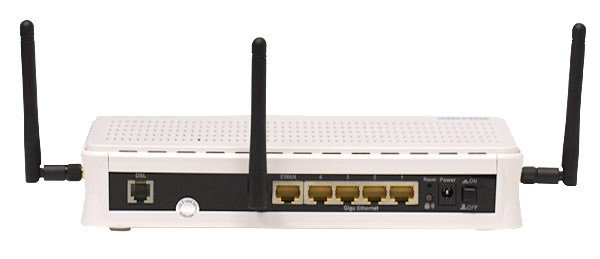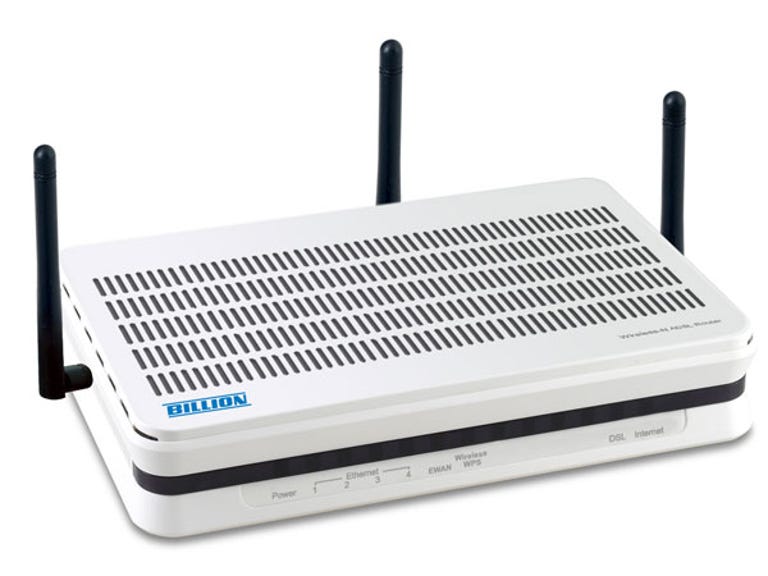 Why You Can Trust CNET
Why You Can Trust CNET Billion BiPAC 7800N review: Billion BiPAC 7800N
Although it comes without 5GHz capability, the 7800N has great wireless throughput and is a solid base for your ADSL2+ network.
Billion has long had a soft spot in the heart of enthusiasts, as the company that brought us low cost routers that didn't sacrifice in quality. While typically the haunt of the advanced user, Billion maintains its reputation for stability with the 7800N.
The Good
The Bad
The Bottom Line
Specs at a glance
| Firmware tested | 1.05 |
|---|---|
| ADSL2+ modem | Yes |
| Annex M | Yes |
| 3G modem | No |
| Wireless protocols | 802.11b/g/n |
| Highest wireless security | WPA2 |
| WDS | Yes |
| Ethernet ports | 4x gigabit |
| USB print sharing/storage | No |
| Accessories | Ethernet cable, phone cable, PC Range ADSL line filter, CD containing quick-start guide and manual |
Connections

Phone jack, WAN port, four gigabit Ethernet ports, reset and WPS buttons, power socket and power button. (Credit: CBS Interactive)
The 7800N sits above the norm by offering gigabit Ethernet ports and interestingly, a WAN port. Unlike many consumer routers, Billion has chosen not to include USB ports for print sharing or storage — perhaps because usually they are rife with compatibility problems and cause more frustration than joy.
UI and features
Billion's range has never been one for beginners, and the 7800N only goes a small way to make networking easier for the beginner. WPS is disabled by default, and although it has "Basic" and "Advanced" modes in the web user interface (UI), all Basic does is hide the majority of options.
Thankfully, there is a "Quick start" link that will walk the user through the necessary steps to get online and set up wireless, but it makes no effort whatsoever to explain to the user what each setting does.
The UI is split into two versions, "Basic" and "Advanced". Basic isn't so much basic as just displays limited options. Check out Port Forward for more screenshots. (Screenshot by CBS Interactive)
As we've come to expect from Billion, there are options aplenty once you enter the advanced mode. On top of the expected features like a DHCP server (with fixed hosts) and port forwarding, it supports IP aliasing, allows tweaking of transmission power, can schedule when the wireless is available, has URL filtering, an in-built firewall (covering packet filtering and Ethernet/wireless MAC filtering), QoS settings, dynamic DNS support and, interestingly, can even set up VLANs across its Ethernet ports.
Performance
After analysing the spectrum with InSSIDer, an empty channel of either 1, 6 or 11 is chosen for 2.4GHz wireless testing. The router is restricted to the 20MHz band and will only allow 802.11n clients. If possible, the MCS is set to 15.
We use iperf to determine throughput, running eight streams, with a TCP window size of 1MB, and an interval of one second. The test is run for five minutes in three different locations, on two separate occasions. The locations are in the same room as the router, one floor down around spiral stairs and with concrete walls and floors, and two floors down under the same conditions.
The wireless throughput is tested using three chipsets, the Atheros AR5008X, RaLink RT2870 and Intel 5100AGN, then all results are averaged.
(Longer bars indicate better performance)
ADSL performance is simply measured by the sync speed on an Internode ADSL2+ connection to the St Leonards exchange, on Internode's very high speed profile. If the connection remains stable over a period of time, the sync speed is recorded.
(Longer bars indicate better performance)
As far as ADSL2+ performance is concerned, all are very close, and during subjective testing maintained a stable link.
Power consumption
We measured power consumption using a Jaycar mains digital power meter. It's important to note here that due to limitations of the meter, measurements are limited to values 1W and greater, and are reported in 1W increments.
The wireless radio was turned on, and an iperf test begun for measurement, using one wireless client and one wired.
| Juice Box |  |
|---|---|
| Transmitting | 9W |
| Idle | 7W |
Nothing out of the ordinary here — this is pretty standard consumption for a modem/router.
Warranty
A 24-month warranty is offered on all Billion products, and is covered by PCRange, Billion's distributor in Australia.
Conclusion
While some ADSL2+ modem/routers we've tested prefer one chipset over another, the Billion 7800N provided the most consistent results across all three of our test platforms, netting it the highest average throughput of the modem/routers we've seen so far. While we'd love to see 5GHz capability in the device, we can highly recommend this to anyone looking for the core of their new ADSL2+-based network.



